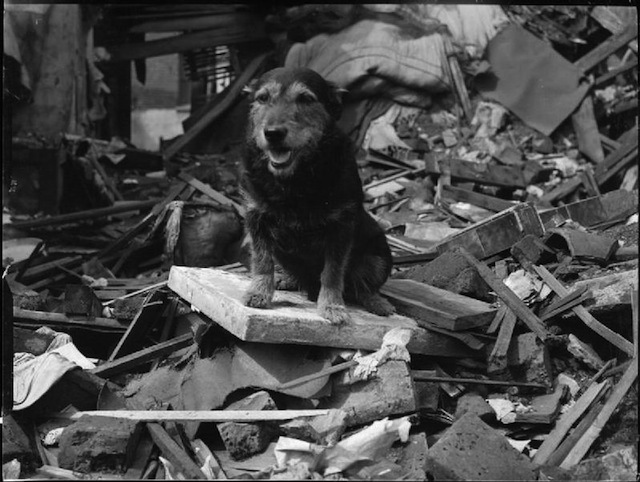
Today, the use of dogs to locate people lost beneath the rubble of ruined buildings is standard practice. It's such a logical extension to normal search and rescue techniques that few realise its beginnings were purely accidental, and can be traced back to the London Blitz
The sustained bombing of London and other major cities from September 1940 brought the reality of war into people’s lives. Causing widespread disruption, 40,000 deaths, and as many as 1 million London houses wrecked, the authorities were in danger of being swamped by calls for help from Londoners convinced a friend or family member was buried somwhere in the rubble.
Initially the job of finding them fell to the ARP wardens, mostly old men considered unsuitable for military service and, in two celebrated cases, to a couple of stray dogs the men had adopted (or more likely the other way round). Quickly proving their worth by finding scores of victims, the pair – Rip and Tipperary Beauty – were among the earliest recipients of the prestigious Dickin Medal (the so-called animals’ Victoria Cross), and went on to inspire the creation of special dog patrols trained to find the living and the dead.
Rip
This plucky little East End waif was adopted by Mr E King, a warden based at Southill Street near Poplar’s Langdon Park. Homeless and hungry, Rip’s keen sense of smell, sense of adventure and intrepid, terrier-like nature meant the mongrel was invaluable when it came to searching the rubble. Braving smoke, fire, explosions from delayed-action fuses, falling masonry and the inevitable danger of clambering over charred and unstable ruins, what other dogs were later taught through weeks of intensive specialist training Rip knew intuitively.
The metronomic beat of his short stubby tail and those little paws pushing away at bricks and masonry were the first sign that somebody was down there and needed help. In all, he is known to have saved more than 100 lives as well as finding many bodies of loved ones, thereby bringing closure to their families and avoiding a potentially horrible health hazard.
Rip was presented with a Dickin medal in 1945, which he continued to wear while engaged in his work. Sadly, exhausted by the effort, he died in 1946 and in 2009 the medal was sold at auction for an astonishing £24,250.
Tipperary Beauty
A little wire-haired terrier, Beauty worked for one of the rescue squads run by the animal charity, the PDSA, which rescued and rehabilitated more than 250,000 animals trapped in the burning wreckage of east London or rendered homeless by the destruction.
She belonged to Bill Barnet, a charity superintendent, and one evening in 1940 was observed pawing at some rubble a little way from where Bill’s team was working. Trusting the little dog’s instincts as her digging became faster and more frantic, and struck by her determination, Barnet moved across and started to excavate the rubble. The result was the first of more than 60 rescues attributed to the dog, for which she too was awarded the Dickin Medal – one of just 63 such presentations made in nearly 70 years. Today she is interred at the charity’s Ilford Pet Cemetery, the final resting place of a dozen Dickin Medal holders.
Jet of Iada
Clearly such important work could not be left to strays and volunteers, and before long the Civil Defence authorities began training dogs in urban search and rescue using techniques still practiced today (for example at Ground Zero where more than 300 professional dogs laboured for many weeks).
Jet of Iada was one of the first, a German Shepherd brought to London at a time when Hitler’s new V1 and V2 Vergeltungswaffe or revenge weapons were exacting a terrible price from the beleaguered city. In all, Jet is known to have located 125 individuals beneath the ruins, half of whom were pulled from the ground alive. Braving fire as well as the noise and chaos animals instinctively shy away from, Jet routinely remained on duty around the clock and on numerous occasions found victims when the human searchers were convinced there was nothing to be done.
These brief excerpts are taken from David Long’s latest book The Animals’ VC: Gallantry & Devotion (Random House), which tells for the first time the authorised histories of every Dickin Medal recipient — dogs, horses, birds and a single, fabulous cat — since the award’s creation in 1943. David's ebook The London Olympics: 1908, 1948, 2012 is also available now, published by Londonist.
See also: London's Top Dogs



